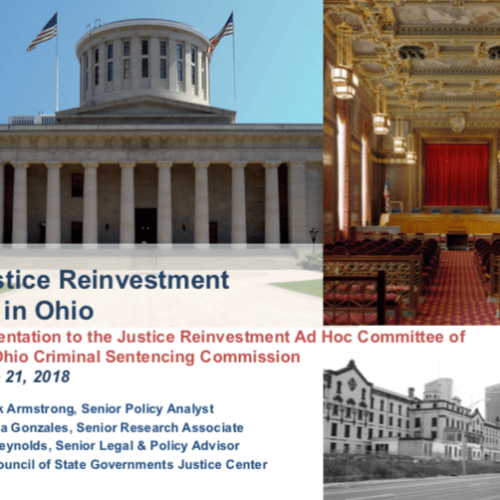Justice Reinvestment in Ohio
The Problem
In 2011, Ohio’s prisons were operating at 33 percent over capacity, with about 51,000 people in its facilities, a population that was projected to grow by 3,000 by 2015. From 2010 to 2011, the CSG Justice Center worked with Ohio state leaders to develop data-driven policy options designed to curb prison population growth, reduce corrections spending, and increase public safety. HB 86, Ohio’s Justice Reinvestment legislation, was signed into law in 2011. As a result, Ohio was able to avert growth in its prisons by approximately 2,900 people.
Ohio continued to face several criminal justice challenges, however. In 2017, despite the fact that the state’s total crime rate had decreased in recent years, the number of murders and aggravated assaults was rising, with individual cities experiencing this increase to varying degrees. The use of opioids and other substances was overwhelming local communities, causing the arrest and imprisonment of people for drug offenses to increase and sparking a need to determine the proper way for the criminal justice system to respond and ensure that treatment and other interventions are accessible and effective.
Local probation officers were supervising a large number of people in the community, and although the state supported local supervision officers, the limited amount of county data and information about supervision policies and practices made it hard for the state to accurately assess local needs and provide targeted support. Finally, the state’s capacity to invest resources in tackling these local public safety challenges was hindered by high corrections spending and a large prison population.
How JRI Helped
To address these challenges, in July 2017, state leaders requested support from the U.S. Department of Justice’s Bureau of Justice Assistance (BJA) and The Pew Charitable Trusts (Pew) to explore a Justice Reinvestment approach.
In September 2017, the Ohio Criminal Sentencing Commission voted to establish the Ohio Justice Reinvestment Committee comprising designees from all three branches of government and state and local criminal justice system stakeholders. Under the direction of the committee, CSG Justice Center staff conducted a comprehensive analysis of data and helped develop policy options to improve access to effective behavioral health supports and services for people in the justice system; reduce crime; and adopt more cost-effective sentencing, corrections, and supervision policies.




























